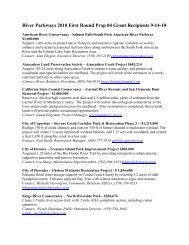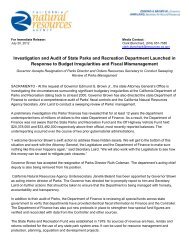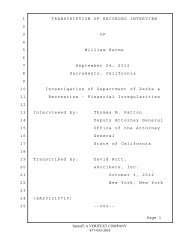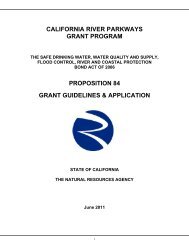California's Ocean Economy - California Resources Agency - State ...
California's Ocean Economy - California Resources Agency - State ...
California's Ocean Economy - California Resources Agency - State ...
You also want an ePaper? Increase the reach of your titles
YUMPU automatically turns print PDFs into web optimized ePapers that Google loves.
NOEP<br />
Chapter 2 Summary of Findings<br />
2.1 Introduction<br />
This chapter has been separated into four categories highlighting the more interesting<br />
findings. The first two categories are (1) <strong>California</strong>’s Coastal <strong>Economy</strong>, which includes the<br />
demographic patterns that define and drive it; 10 and (2) comparison of <strong>California</strong>’s <strong>Ocean</strong><br />
<strong>Economy</strong> with the nation that also includes other coastal states. These are added solely to<br />
provide context and a fuller understanding of the data generated for this report, yet are not<br />
analyzed or elaborated further. The second two categories, (3) comparison of <strong>California</strong>’s<br />
Regional <strong>Ocean</strong> Economies with each other and with the state over time; 11 and (4)<br />
comparison of <strong>California</strong>’s <strong>Ocean</strong> <strong>Economy</strong> by sectors, over time are further elaborated in<br />
the following chapters.<br />
2.2 <strong>California</strong>’s Coastal <strong>Economy</strong><br />
As explained in Chapter 1, <strong>California</strong>’s Coastal <strong>Economy</strong> reflects all activities within either<br />
coastal zip codes or coastal counties, which are part of the <strong>California</strong> Coastal Zone<br />
Management Program. This includes all counties with ports and harbors in watersheds that<br />
host important maritime activities. Population and housing estimates are added to show<br />
important trends.<br />
<strong>California</strong>’s coastal population did not increase as rapidly as the state’s population during the<br />
decade between 1990 and 2000, (11.3% compared to the total state population growth of<br />
13.7%, a difference of 2.4%). However, density of <strong>California</strong>’s coastal population continues<br />
to far exceed that of the state. In the year 2000, density along the coast was more than 623<br />
people per square mile vs. 217people per square mile for the state.<br />
• In 2000, 77% of <strong>California</strong>’s population lived in coastal counties, which represent 25%<br />
of the land.<br />
• According to US Census reports, the areas of highest population growth, however, were<br />
those found immediately adjacent to the coastal areas, inland along coastal watersheds,<br />
where property was less expensive and more available at the time. 12 While population<br />
density in coastal areas clearly exceeds these areas for now, inland areas merit close<br />
monitoring, because they are vulnerable to overexploitation of the natural landscape and<br />
the filling in of valuable and limited green space that could affect the quality of<br />
watersheds and ultimately the shoreline. See Table 2-1, Coastal County densities.<br />
10 <strong>California</strong> <strong>State</strong> Summary of Coastal and <strong>Ocean</strong> Social and Economic Trends, December 2004.<br />
11 The <strong>State</strong> has been divided into 5 regions, as was done in the previous CA study. However, due to changes in marinebased<br />
activities in watersheds, we have added the counties of Yolo, San Joaquin, and Sacramento to ensure that all<br />
significant activities were included.<br />
12 Examples would be the “inland empire” in LA County, the Salinas Valley in Monterey County, the Inland areas of<br />
Sonoma county, the Sacramento Delta areas.<br />
11







